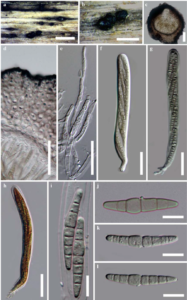Plenodomus agnitus (Desm.) Gruyter et al., Stud. Mycol. 75: 21 (2012)
Facesoffungi number: FoF00411; Fig. 1
Basionym: Sphaeria agnita Desm., Annls Sci. Nat., Bot., sér. 2 15: 18 (1841)
≡Leptosphaeria agnita (Desm.) Ces. & De Not., Comm. Soc. crittog. Ital. 1(4): 236 (1863)
Saprobic on dead stems of Eupatorium cannabinum. Sexual morph Ascomata 137 – 250 μm high, 235 – 453 μm diam., solitary, scattered, or in small groups of 1 – 3, semi-immersed, subglobose to ovoid, with a flattened base, smooth, easily removed from host substrate, black. Ostiole papillate, black. Peridium 37 – 107 μm (x̄ = 71 μm, n = 10) wide, composed of three layers, externally with a 5 – 14 μm thick layer of dark brown to black, opaque cells, central layer composed of hyaline, small, thick-walled cells of textura angularis, inner layer composed of pale brown, textura prismatica. Hamathecium comprising 1 – 3 μm wide, dense, hyaline, broad, septate, cellular pseudoparaphyses, branching above asci and embedded in gelatinous matrix. Asci 66 – 115 × 7 – 10 μm (x̄ = 94 × 9 μm, n = 20), 8 – spored, bitunicate, cylindricsubclavate, with a short, furcate pedicel, rounded at the apex. Ascospores 26 –32 × 3 – 6 μm (x̄ = 29 × 4 μm, n = 40), overlapping uniseriate, narrowly fusoid with sharp to narrowly rounded ends, 6 – 8 – septate, constricted at third or fourth septum, upper third or fourth cell enlarged, pale yellowish-ash, smoothwalled. Asexual morph Undetermined.
Material examined – GERMANY, Senckenberganlage 25, D-60325 Frankfurt (Main), on dead stem of Eupatorium cannabinum L. (Asteraceae), 13 November 2013, H.A. Ariyawansa (MFLU 15-0039, reference specimen designated here). The DNA was extracted from fruiting body. GenBank ITS: KP744459; LSU: KP744504.
Notes – Leptosphaeria agnita was transferred to Plenodomus agnitus by de Gruyter et al. (2013) based on the sequence data. The putative strain of Plenodomus agnitus (CBS 121.89) clustered with our new collection from Germany, on dead stem of Eupatorium cannabinum. Saccardo (1883) originally described Plenodomus agnitus as Leptosphaeria agnita and mentioned the different hosts including dry stems of Eupatorium cannabinum in France, Germany, Britain, Italy and Netherlands. The ascomata, size of asci and ascospores are typical of P. agnitus (Saccardo 1883) and the molecular data is identical to the putatively named CBS 121.89 strain. We therefore designate our collection as a reference specimen (sensu Ariyawansa et al. 2014a) of P. agnitus to stabilize the application of this name.

Fig. 1 Plenodomus agnitus (MFLU 15-0039) a, b Ascomata on host substrate c Vertical section of ascoma d Close up of the peridium e Cellular pseudoparaphyses f, g Asci h Ascus in Melzer’s reagent i Ascospores in the ascus j–l Ascospores. Scale bars: a = 1 cm, b = 500 μm, c = 100 μm, d = 50 μm, e – h = 20 μm, i – l = 10 μm.
